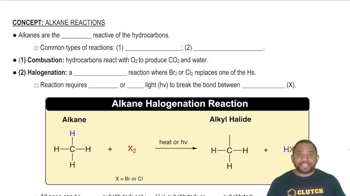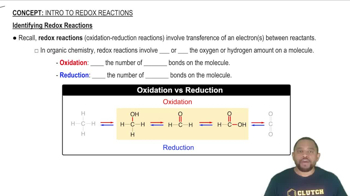Ch.22 - Chemistry of the Nonmetals

Brown15th EditionChemistry: The Central ScienceISBN: 9780137542970Not the one you use?Change textbook
Chapter 22, Problem 24
Complete the exercises below. Write balanced equations for each of the following reactions: a. Aluminum metal reacts with acids to form hydrogen gas. b. Steam reacts with magnesium metal to give magnesium oxide and hydrogen. c. Manganese(IV) oxide is reduced to manganese(II) oxide by hydrogen gas. d. Calcium hydride reacts with water to generate hydrogen gas.
 Verified step by step guidance
Verified step by step guidance1
Identify the reactants and products for each reaction. For example, in reaction (a), the reactants are aluminum metal and an acid, and the products are hydrogen gas and a salt formed from the acid.
Write the unbalanced chemical equation for each reaction. For reaction (a), it would be: \( \text{Al} + \text{HCl} \rightarrow \text{AlCl}_3 + \text{H}_2 \).
Balance the chemical equation by adjusting the coefficients to ensure the same number of each type of atom on both sides of the equation. For reaction (a), balance the aluminum, chlorine, and hydrogen atoms.
Repeat the process for each subsequent reaction, ensuring to write the unbalanced equation first, then balance it. For example, for reaction (b), start with \( \text{Mg} + \text{H}_2\text{O} \rightarrow \text{MgO} + \text{H}_2 \).
Check each balanced equation to ensure mass and charge are conserved, meaning the number of atoms and the total charge are the same on both sides of the equation.
Key Concepts
Here are the essential concepts you must grasp in order to answer the question correctly.
Balancing Chemical Equations
Balancing chemical equations is essential to ensure that the law of conservation of mass is upheld, meaning the number of atoms of each element must be the same on both sides of the equation. This involves adjusting coefficients in front of compounds to achieve balance, reflecting the stoichiometry of the reaction.
Recommended video:
Guided course

Balancing Chemical Equations
Types of Chemical Reactions
Understanding the types of chemical reactions, such as single displacement, double displacement, synthesis, and decomposition, is crucial for predicting the products of reactions. For example, reactions involving metals and acids typically result in hydrogen gas and a salt, while metal oxides can be formed through reactions with steam.
Recommended video:
Guided course

Common Types of Alkane Reactions
Redox Reactions
Redox (reduction-oxidation) reactions involve the transfer of electrons between substances, leading to changes in oxidation states. In the context of the question, recognizing which species are oxidized and reduced is vital, such as manganese(IV) oxide being reduced to manganese(II) oxide by hydrogen gas, indicating a gain of electrons.
Recommended video:
Guided course

Identifying Redox Reactions
Related Practice
